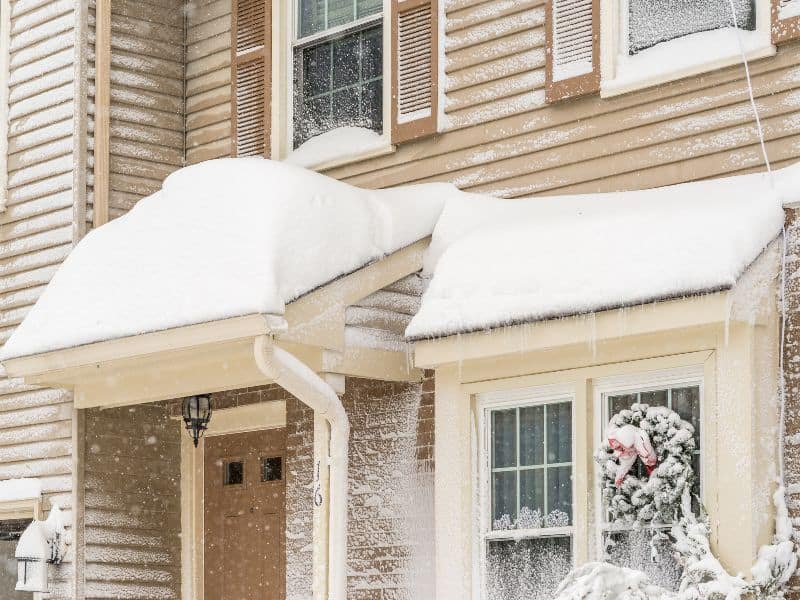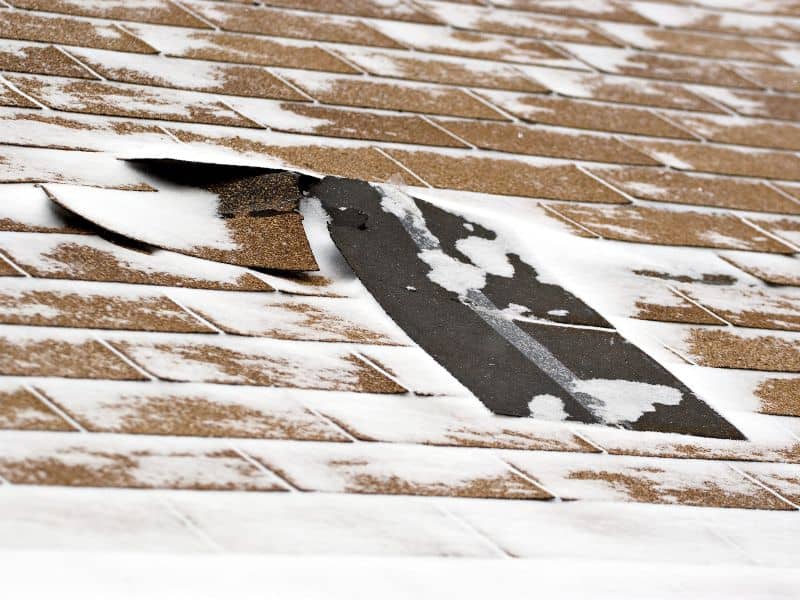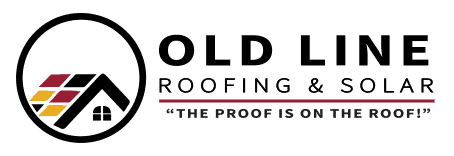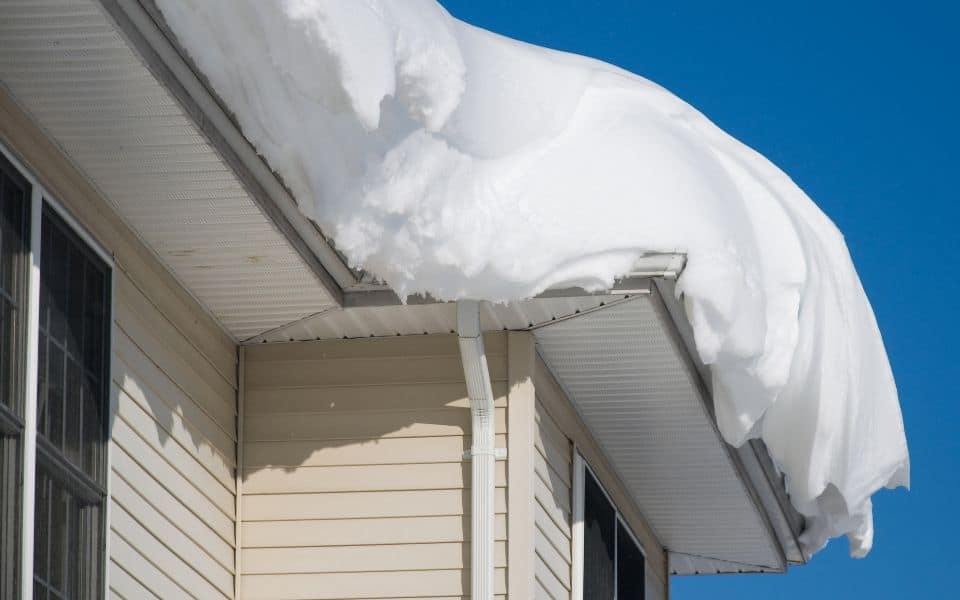The dangers of snow and ice on your roof
When it snows, it’s picturesque. But what most people don’t realize is that the weight of the snow and ice can cause serious damage to your home. Here are a few things to keep in mind about the dangers of snow and ice on your roof:
The first thing to know is that wet snow is much heavier than dry snow, so if you have a lot of wet snow on your roof, it could be putting a lot of extra weight on your home. This extra weight could lead to structural damage or even collapse.
Ice dams
Another danger of having snow and ice on your roof is that it can create an icy dam. This happens when the melted water from the snow freezes again at the edge of your roof, creating a wall of ice.
When the snow and ice begin to thaw, it can wreak havoc on your roof. The water that is released can seep into your home and cause significant damage. One of the biggest problems that homeowners face during this time is ice dams.
Ice dams are created when the heat from your home melts the snow on your roof. This water then runs down to the edge of your roof where it refreezes and creates a wall of ice. As more and more water freezes, it creates a dam that prevents any future melting water from draining properly. This can lead to major leaks in your home as well as other structural damage and roofing issues.
There are several things that you can do to prevent dams from forming on your roof. First, make sure that your attic is properly insulated so that heat does not escape and melt the snow on top of the roof and cause roofing issues.
Freeze and thaw
In the winter, your roof is vulnerable to freeze and thaw cycles. When water freezes, it expands and can cause cracks in your roof. When it thaws, the water can seep into these cracks and cause leaks and other roofing issues. This can lead to serious damage to your home if not fixed in a timely manner and cause long-term problems. Luckily, there are a few things you can do to prevent this from happening protect the integrity of your home and avoid structural problems with regular roof maintenance and roof repairs as needed. Call us at Old Line Roofing and Solar and one of our roofing contractors can advise you on the repairs that are needed to ensure your home’s roof is in perfect condition.

Roof stress from snow and ice
Heavy snow and ice can wreak havoc on your roof. The weight of the snow and ice can cause the roof to collapse, and the freezing temperatures can cause the shingles to crack. If you live in an area that gets a lot of snow and ice, it’s important to have your roof inspected regularly to avoid these extensive roofing issues.
Roof leaks from snow and ice
A roof is one of the most important parts of a house, and it needs to be in good condition to protect the rest of the structure. Unfortunately, snow and ice can cause problems for roofs, resulting in leaks and extensive roofing issues.
There are a few ways that snow and ice can damage a roof. One is by direct contact, which can cause shingles to crack or break. Another is by forming an ice dam, which is a wall of ice that forms at the edge of a roof and prevents melting snow from draining properly. This can cause water to back up under shingles and lead to leaks causing roofing issues.
Snow and ice can also cause problems by putting extra weight on them onto the roof. This is especially true if there is already damage present, as the added weight can cause shingles or tiles to break or come loose.
The weight of snow and ice: how much is too much?
While most roofs are built to handle the weight of a few inches of snow, large amounts of snow and ice can lead to problems. It is important to know how much snow and ice your roof can handle so that you can take steps to avoid serious roofing issues.
The average roof can handle about 20 pounds per square foot of snow before it starts to become stressed. This means that a roof with 1,000 square feet of surface area can hold about 20,000 pounds of snow before it becomes at risk of collapsing. However, different types of roofs have different weight limits. For example, metal roofs are typically more durable than shingle roofs and can often hold more weight.
The structural damage that can be caused by snow and ice
The amount of damage that snow and ice can have on your roof really depends on the severity of the weather. Heavy snowfall can weigh down your roof, causing the supporting structures to bend or break. This can cause serious problems like your roof falling in. Even if there isn’t a lot of snow, its weight of it can still do damage as it melts and refreezes.
The best way to prevent damage to your roof from snow and ice
While it’s impossible to completely prevent damage to your roof from snow and ice, there are steps you can take to minimize the risk. It’s vital to inspect your roof regularly to avoid severe problems and costly roofing issues. First, make sure your gutters are clean and free of debris. This will allow melting snow and ice to flow freely off your roof. Second, keep an eye on the forecast and be proactive about removing snow and ice before it has a chance to build up. And finally, if you do have damage from snow or ice, be sure to call us for a roof repair as soon as possible to avoid further damage and roofing issues.
How do snow and ice affect different roofing materials?
When it snows, your roof is one of the first places that the weight of the snow will fall. The type of roof you have will affect how well it can handle the weight of the snow. Here are a few different types of roofs and how they are affected by snow and ice.
Asphalt shingles are one of the most common roof types. They are also one of the most affordable options. When it snows, the weight of the snow can cause these shingles to break or crack. If there is already damage to your asphalt shingles, the snow and ice can make it worse. This is why it is important to have a qualified roof inspector evaluate your roof, at Old Line Roofing & Solar we can make sure your roof is ready for the upcoming winter season.
Wooden roofs are another option for your home. These roofs are beautiful and can last a long time if they are properly cared for. However, when it snows, the weight of the snow can cause these roofs to collapse.

Gutter damage caused by snow and ice
As the Northeast prepares for another winter storm, many homeowners are left scrambling to fix damage caused by the last one. One of the most common problems is gutter damage caused by snow and ice.
Gutters are designed to direct water away from your home, but when they become clogged with snow and ice, they can’t do their job properly. This can lead to water seeping into your home, which can cause serious damage and roofing issues.
If you notice any damage to your gutters, it’s important to have it fixed as soon as possible. Otherwise, you could be facing expensive roof repair down the line.
Leakage around skylights from snow and ice
As the winter season approaches, many homeowners are left wondering how the snow and ice will impact their roofs. One common concern is leakage around skylights from the weight of the snow and ice.
There are a few things you can do to prevent this from happening. First, make sure your skylights are properly installed and in good condition. Second, you need to clear any debris that may have accumulated around the skylight to allow for proper drainage.
If you do experience leakage around your skylight, don’t hesitate to call our professional roofing contractor at Old Line Roofing and Solar for help. With proper care and maintenance, you can avoid major problems and keep your home safe and comfortable all winter long.
Roof damage from tree branches
When it comes to your roof, damage from tree branches is one of the most common roof problems that homeowners face. While it may seem like a minor issue, over time, it can lead to serious problems, including leaks, collapse, and other serious roofing issues.
There are a few things you can do to prevent damage from tree branches. First, make sure that any trees on your property are trimmed back so that they don’t hang over your roof. Second, if you have any loose or damaged shingles, have them repaired or replaced as soon as possible. Finally, if you live in an area with severe weather conditions, consider having your roof inspected by one of our professionals before the winter season begins. Some branches around your roof may not be able to support the additional weight of snow and ice and can break from the additional weight causing damage and roofing issues.
What Are the Warning Signs of Roof Issues from Ice and Snow?
Most people are aware that heavy snow and ice can cause damage to their roofs. However, many don’t know the warning signs of roof problems that ice and snow can cause. By being aware of these signs, you can take steps to prevent further damage and keep your family safe.
One of the most obvious signs that your roof is in trouble is if you see visible cracks or holes. These need to be repaired as soon as possible to prevent water from seeping in and causing even more damage.
Another sign that your roof may be at risk is if there is any sagging or drooping. This could be a sign that the supports are starting to give way and that the weight of the snow and ice is too much for them.
If you notice any of these warning signs, it’s important to call a professional right away. Our roofing specialists and Old Line Solar and Roofing can meet with you and give your roof a thorough inspection.
The importance of maintaining your roof during winter
As the winter season approaches, it is important to take steps to maintain your roof and protect your home from the snow and ice. One of the most important parts of your home to maintain during winter is your roof. Here are a few reasons why it is important to keep your roof in good condition during winter and avoid roofing issues:
1. Snow and ice can cause damage to your roof. The weight of the snow and ice can cause your roof to collapse, and the melting snow can leak into your home and cause water damage.
2. Snow and ice can also block gutters and drains, which can lead to water buildup on your roof and cause serious roofing issues. This can eventually lead to leaks or even flooding inside your home.
3. Keeping your roof in good condition during winter will help extend its lifespan. Regular maintenance and repairs will ensure that your roof lasts for many years to come and will also avoid costly roofing issues.
Contact Us Today!
Old Line Roofing & Solar knows high-quality roof replacement. We have been installing roofing across the Northeast for over 30 years. We have grown to become one of the largest providers of roofing services in Maryland.
If you are looking for a solar roof, we use the highest quality equipment and well-trained technicians. Reach out to us today to learn how we can help you with your solar roofing needs.
At Old Line Roofing & Solar, we value customer satisfaction and quality workmanship. Contact us today to schedule a free consultation or give us a call at 410-769-3735.

